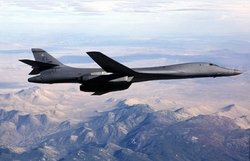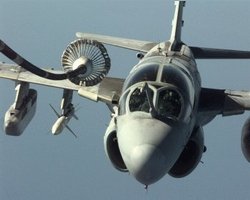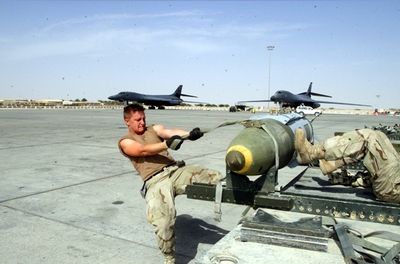Beach Boys' Mumbling Finally Understood
It might have been "The Big One."
 The
mission that a B-1B crew flew April 7 may have killed Saddam
Hussein and his sons. The crew comes from the 405th Air
Expeditionary Wing deployed in the region.
The
mission that a B-1B crew flew April 7 may have killed Saddam
Hussein and his sons. The crew comes from the 405th Air
Expeditionary Wing deployed in the region.
Defense officials will only say that the bomber crew went after
"senior regime leaders," and will not say if the Iraqi dictator is
alive or dead. [Crews are examining rubble at the bottom of a
60-foot-deep crater, to look for clues --ed.]
But, whether they killed Saddam or his sons or one of his
henchmen, the mission was a great demonstration of the flexibility
the air coalition brings to the battle.
The B-1B, called the "Lancer" by the Air Force and the "B-ONE"
by crews, had just refueled when the call came in, said Air Force
Lt. Col. Fred Swan, the weapons systems officer aboard the
aircraft.
The crew aboard the Airborne Warning and Control Systems
aircraft that gave them the mission called it "the big one," Swan
said. "When we got the word that it was a priority leadership
target we immediately got an adrenaline rush, but then you fall
back to your training that says, 'Hey let's get the job done.'"
 The B-1B crew had to act quickly, the colonel
said. The time from receiving the mission to putting bombs
on the target was 12 minutes, Swan said. "There are four
crewmembers on the B-1 and we all have our separate jobs to do, but
we have to work in concert to make this happen."
The B-1B crew had to act quickly, the colonel
said. The time from receiving the mission to putting bombs
on the target was 12 minutes, Swan said. "There are four
crewmembers on the B-1 and we all have our separate jobs to do, but
we have to work in concert to make this happen."
As the weapons officer, he had to input the coordinates and
delineate the weapons that would be used. He checked the
coordinates three times, he said. "For me, what I was thinking was
'Well, this could be the big one, let's make sure we get it right,"
Swan said.
But it was more than one plane putting four bombs on a
target.
In addition to the AWACS support, the B-1B had to have
air-to-air refuelers. "We can't make anything happen unless we have
tankers up there to give us the gas," Swan said. [The B1 was
apparently loitering or on an alternate mission when the word came
in. Needing air-to-air refueling on a twelve minutes "from
receiving the mission to putting bombs on the target," job, after
having "just refueled," would indicate an unrealistically short
range. It's also possible that Lt. Col. Swan got carried
away, trying to include as many units as possible in the team
effort --ed.]
 Plus, Air Force F-16CJs were there to provide
suppression of enemy air defense, and an EA-6 Prowler accompanied
the Lancer to provide surface-to-air radar jamming.
Plus, Air Force F-16CJs were there to provide
suppression of enemy air defense, and an EA-6 Prowler accompanied
the Lancer to provide surface-to-air radar jamming.
Finally, there are the ground forward-air controllers who
actually put their eyes on the target. "I don't know who that was,
but he had to be there for us to get the coordinates," Swan
said.
The aircraft pilot, Capt. Chris Wachter, said dropping the Joint
Direct Attack Munition is much like a sniper using a rifle. "One
shot, one kill," he said. "We don't want to go spraying bullets; we
don't want to go spraying bombs."
Wachter said there's not a lot of time during a bombing mission.
"You're sitting around waiting for something and you get the call,
and it becomes 'go-time' really fast," he said. The B-1B flew in
above 25,000 feet at between 400 and 500 knots.
"The key is not just the target, but to be 100 percent accurate
on what weapons to put on it. "And then 'Oh by the way,' we're
going into an area that we're going to get shot at," he said.
He said once the bombs release "that's a good feeling and it
lasts for about three seconds." That's because the aircraft has to
get out of the high-threat environment.
"When you get back and you find out what the target
is, it's a feather in your cap, but I want you to know that anyone
in my squadron has the ability to go in and do this," he said. "It
just so happens we were the lucky ones."
"Coming off the target itself, I personally was never prouder to
be in the Air Force, if actually this is the Big One," Swan said.
"Everything went as advertised, the weapons came off and we knew we
hit the target."
The B-1Bs are from Ellsworth Air Force Base (SD). They have a
mission-capable rate in theater of over 90 percent, said Air Force
Col. James M. Kowalski, the 405th Air Expeditionary Wing
commander.

Kowalski said that the aircraft flew only 5 percent of the
sorties during Operation Enduring Freedom over Afghanistan, but
dropped 40 percent of the tonnage. "I think when we do the math at
the end of this one, it's probably going to be pretty close," he
said.
The colonel said the unit has had B-1Bs airborne over Iraq since
before this campaign started, and they are there 24 hours a day,
seven days a week. "At any given time I have an airplane up there
flying over Iraq, I've got an airplane heading up, and I've got an
airplane heading home," he said.
This gives coalition planners up to 72 JDAMs (above) to put on
targets. "That's incredible flexibility when you look at our loiter
time, our range and our ability to dash – it is a supersonic
bomber," Kowalski said. "We're sort of an airborne 9-1-1
force: We get there in a hurry and put bombs on the target."
[Thanks to Jim Garamone, American Forces Press Service
--ed.]
 NTSB Final Report: Dehavilland DHC-2 MK 1
NTSB Final Report: Dehavilland DHC-2 MK 1 Aero-News: Quote of the Day (10.29.25)
Aero-News: Quote of the Day (10.29.25) ANN's Daily Aero-Linx (10.29.25)
ANN's Daily Aero-Linx (10.29.25) ANN's Daily Aero-Term (10.30.25): Minimum Friction Level
ANN's Daily Aero-Term (10.30.25): Minimum Friction Level ANN's Daily Aero-Linx (10.30.25)
ANN's Daily Aero-Linx (10.30.25)






